Best active speakers 2025: our experts pick the top pairs with integrated amplifiers
Neat, high-performing stereo speakers with built-in amplification (and sometimes streaming)
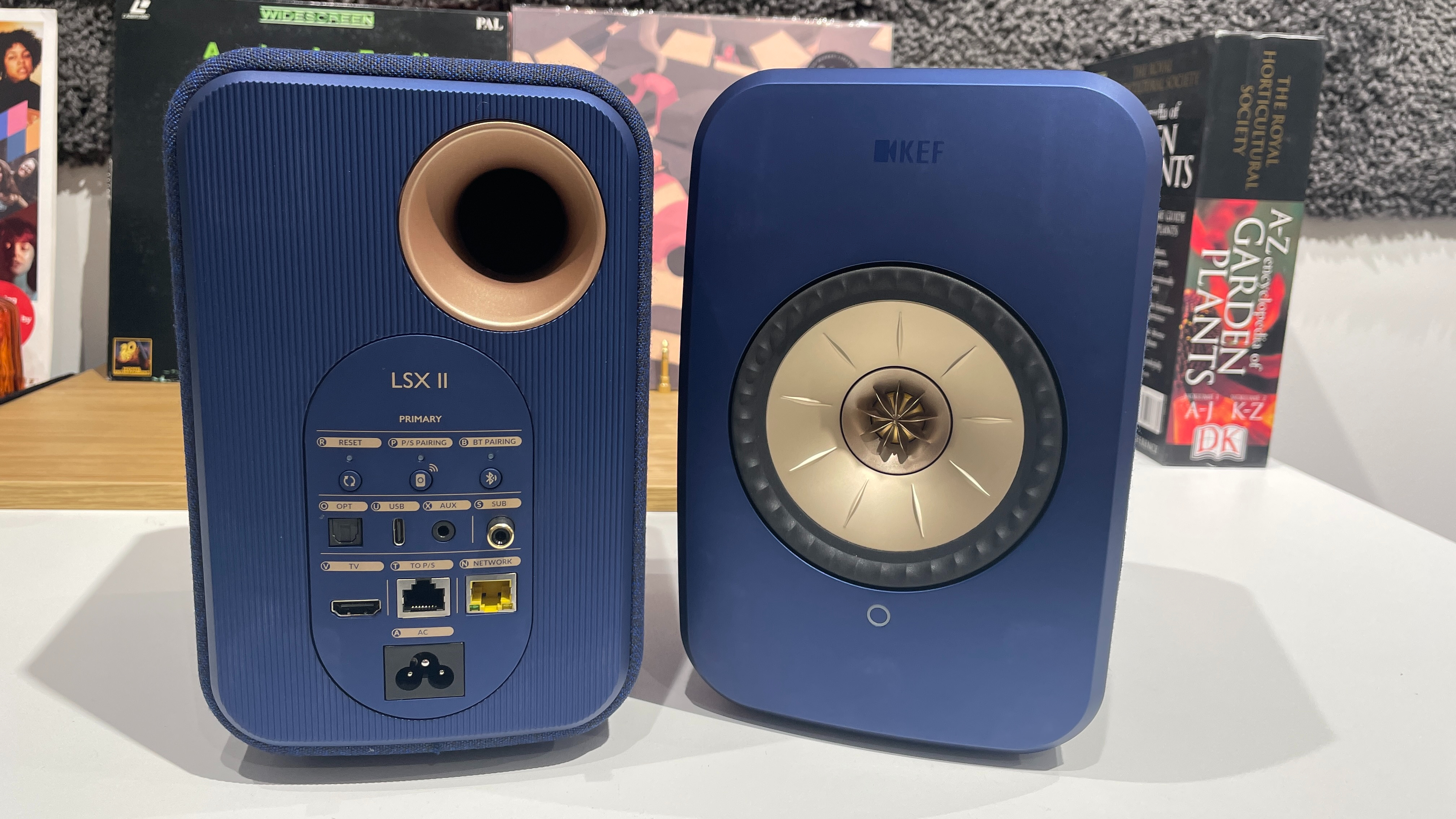
If you want a hi-fi system but are daunted by the prospect of multiple speaker and amplifier boxes, you may want to consider active speakers – i.e. speakers with amplification built-in.
Hi-fi systems require three elements: a source that plays music, such as a turntable or streamer; an amplifier to strengthen the audio signal; and finally, a pair of speakers to output that boosted signal. But each job doesn't necessarily require a separate box; active speakers can perform the latter two roles, meaning all you need to complete the hi-fi picture is a source.
While they often look like 'standard' (passive) speakers from the front, don't be fooled: there's a lot of power and clever processing inside these cabinets.
Traditionally, active speakers offer physical analogue and digital connections and often support hi-res audio and Bluetooth as well. However, an increasing number of active speakers actually cover all three bases of a complete hi-fi system by also integrating wi-fi connectivity and providing access to the best music streaming services.
If you aren't quite sure exactly what you want or need, jump to our how to choose active speakers section.
As well as active speakers lessening your system's box count, another advantage is the inherently well-matched sonic integration between the amplification and speaker components. So there are a lot of things going for them.
You can read more about how we test and review products on What Hi-Fi? here, or you can jump into the best active speakers, curated by our in-house experts with over 150 years of collective experience.
August 2025: Following their recent five-star review, the ATC SCM20ASL have made their way onto our also consider section. They're a fantastically insightful and transparent pair of speakers, but given their lofty price (£6495 / $9999 / AU$12,950 isn't cheap) we've popped them into the also consider for those buyers with enviably deep pockets.

I'm the managing editor of What Hi-Fi? and have been testing hi-fi kit for over a decade, including my fair share of active speakers! I've seen them expand from amplified speakers with physical connections to those adding Bluetooth and, as is common nowadays, even network streaming. I've heard every pair on this list and so can vouch for their performance, and I've curated this 'best of' list to cover the most desirable pairs across various types and budgets.
The best active speakers overall


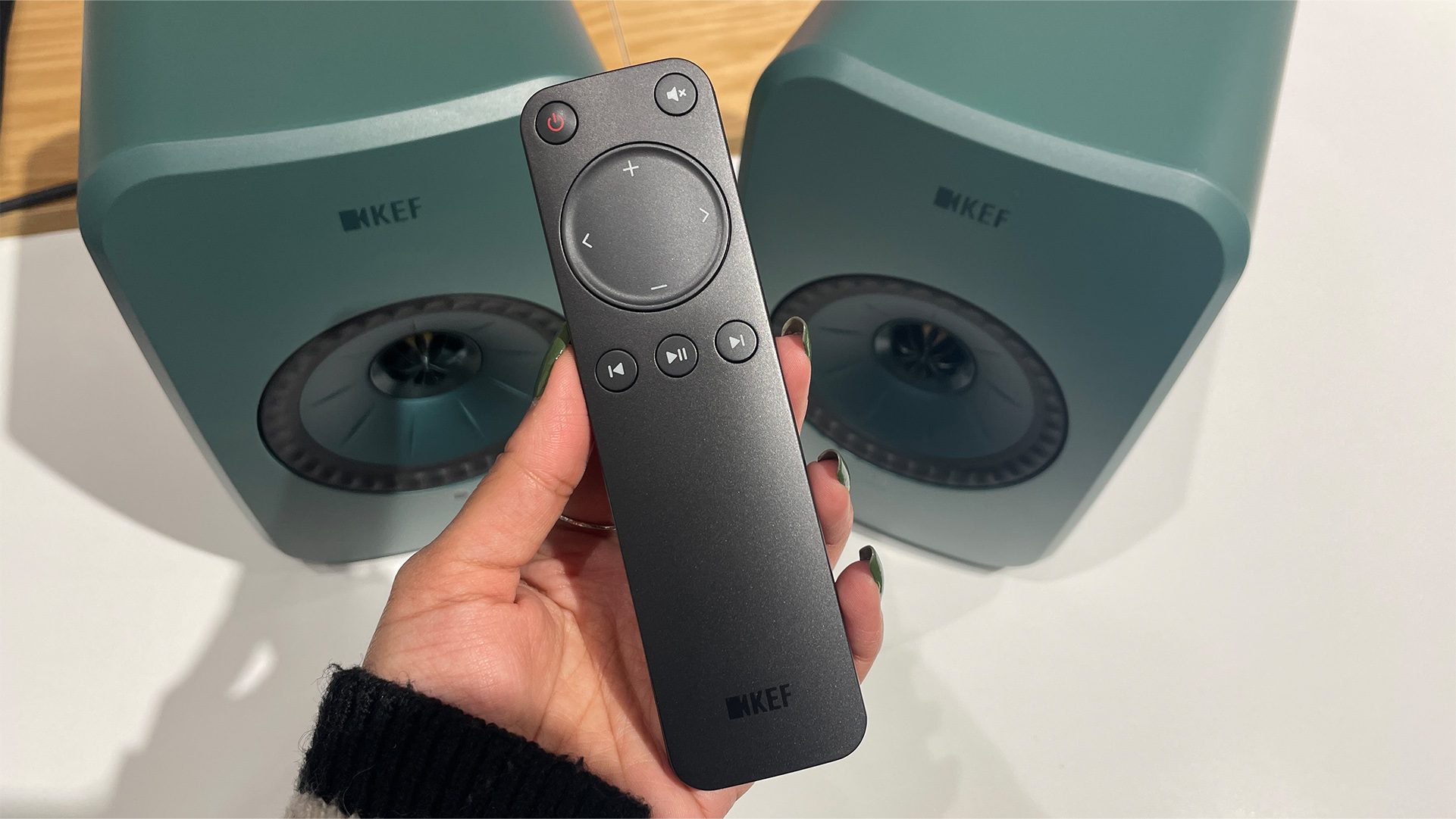
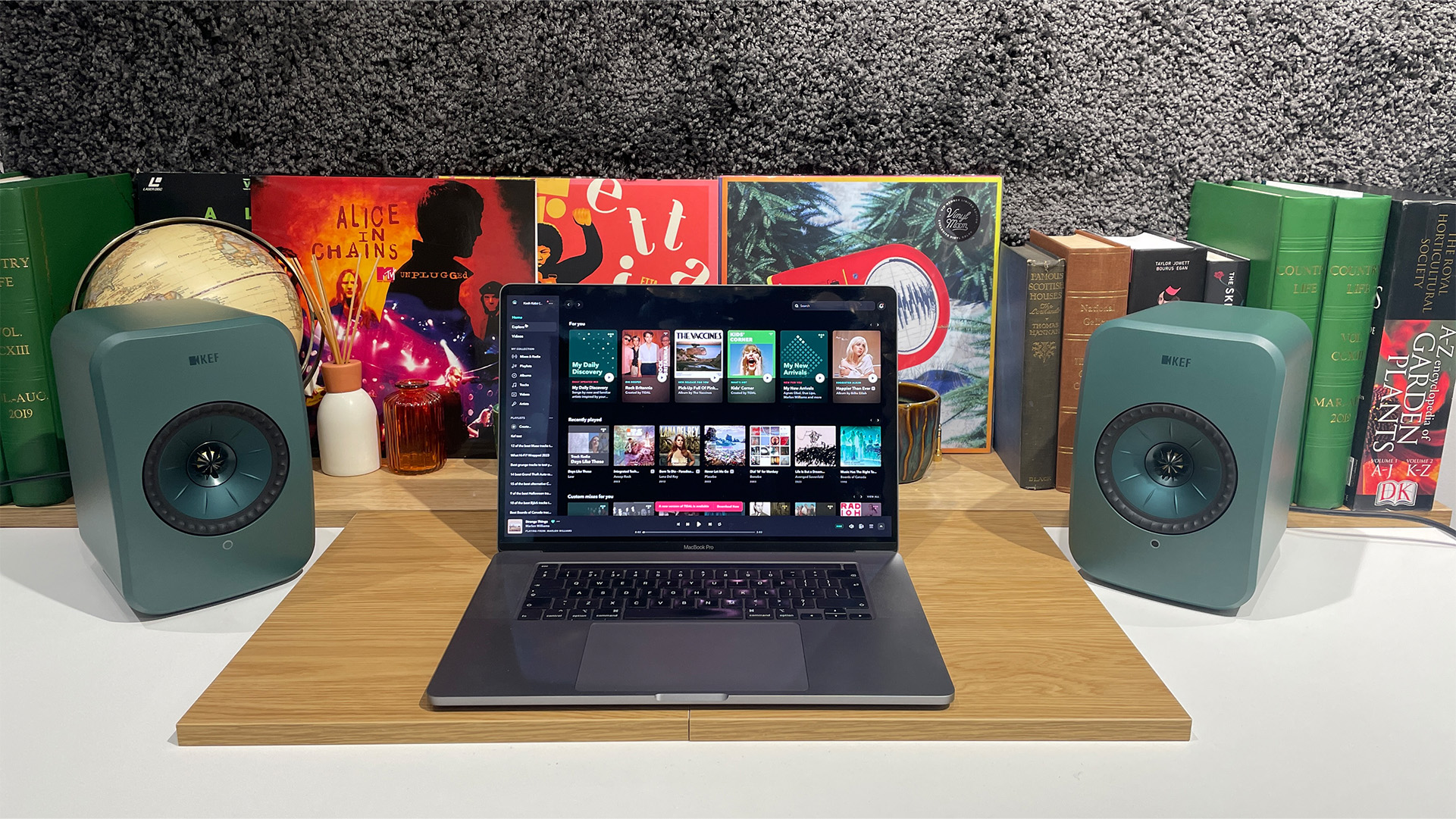
Specifications
Reasons to buy
Reasons to avoid
A network streamer, Bluetooth receiver and amplifier built into a compact pair of stereo speakers – the KEF LSX II LT are great active speakers for those looking for whole-system convenience and musicality from two small boxes.
They are our number one recommendation for those who cannot afford the company's pricier, bigger – and yes, better-sounding – LS50 Wireless II, from which the LSX II LT are the latest and most affordable descendants in the line.
Their closest siblings are actually the older LSX II, which deliver the same sound and cabinet size but don't require a cable between the speakers (they have a wireless link) and do have an aux input. Our expert reviews team found the LSX II LT to be the better value buy, however, and named them a What Hi-Fi? Award 2024 winner over the 2023-winning LSX II.
KEF's first-ever LSX active speakers offered plenty of choice when it came to sources – streaming over DLNA or from Tidal, Spotify Connect, Roon compatibility and AirPlay 2 – but this sequel expands on this with even wider streaming support and the modern-day addition of HMDI ARC and USB-C for TV and laptop/phone connectivity respectively.
Essentially, KEF has taken what was already a winning formula, introduced some key upgrades that improve functionality and usability, and offered a package that nails value better than any LSX design before it.
Without really altering the speaker hardware (no bad thing!), it has produced a talented stereo speaker system that sings with any genre of music sent its way.
As our in-house experts noted in our LSX II LT review, "There’s very little fatness to the KEFs, and while that might have you summoning adjectives such as “thin” or “lean” in your mind, the LSX II LT instead feel immediate, taut and controlled, like a ballerina’s calves as they perform a perfect plié.
The ballet dancer analogy is an apt one, in fact, with the LT also conjuring the sort of subtle mix of emotional expression and insight combined with the deft aptitude for control, poise and perfect balance so often exhibited by the likes of Fonteyn or Nijinsky."
Ultimately, the KEF LSX II is a stylish system that has none of the baggage and boxes a separates set-up brings. The cherry on the top? They come in a smaller range of colours than the LSX II, but graphite grey and stone white should match your home decor, while sage green (pictured) is a lovely-looking colour option.
The Dali Oberon 1 C active speakers, which are similar in form and features albeit slightly larger and come with a separate hub for housing all of their connectivity, are also worth considering around this price point.
Of course, the LSX II are also recommendable if you find the wireless link and/or aux input is worth paying a modest premium for.
Can't quite stretch your budget to these KEFs? Consider the Triangles below.
Read our full KEF LSX II LT review
The best budget active speakers

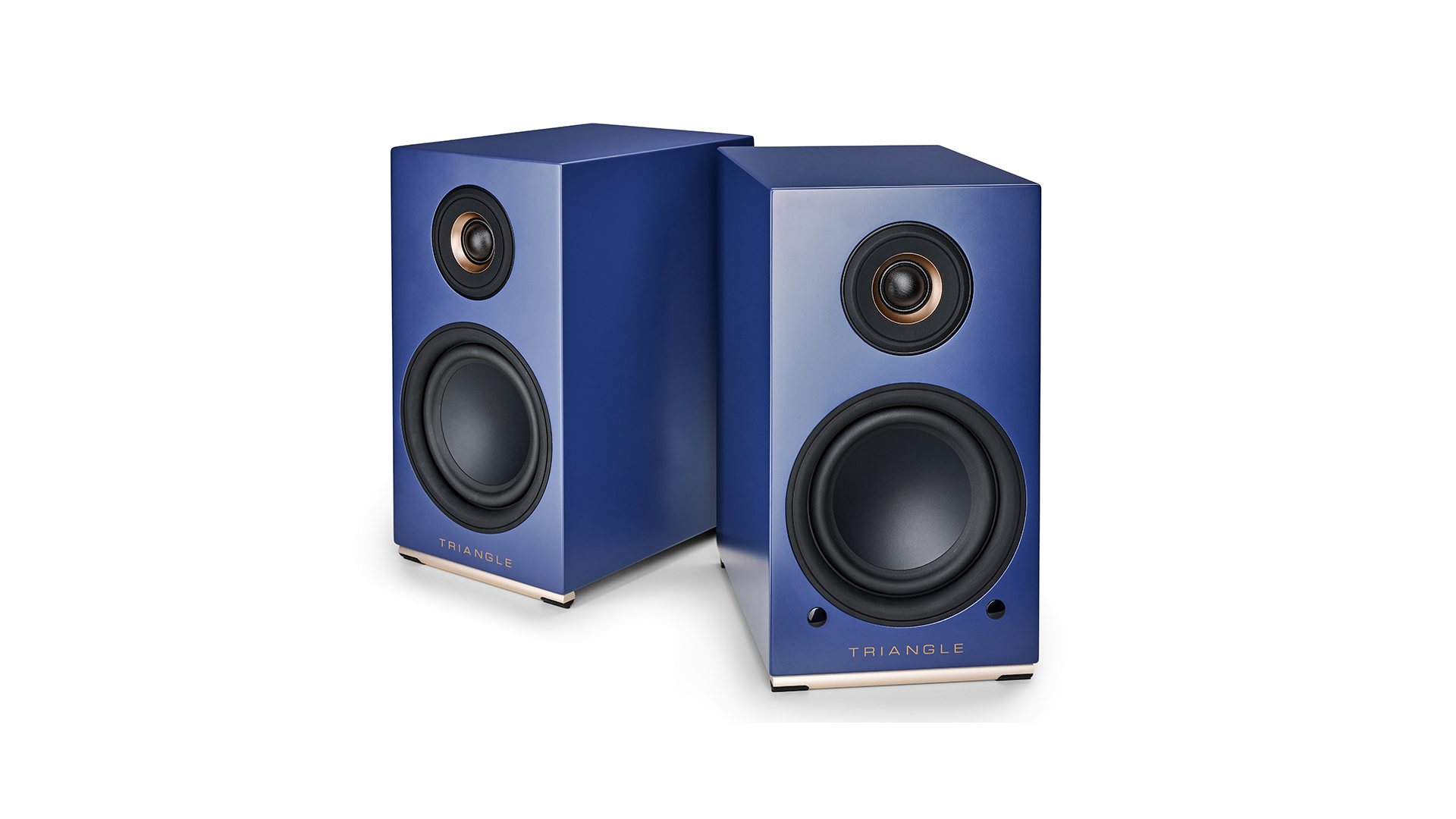

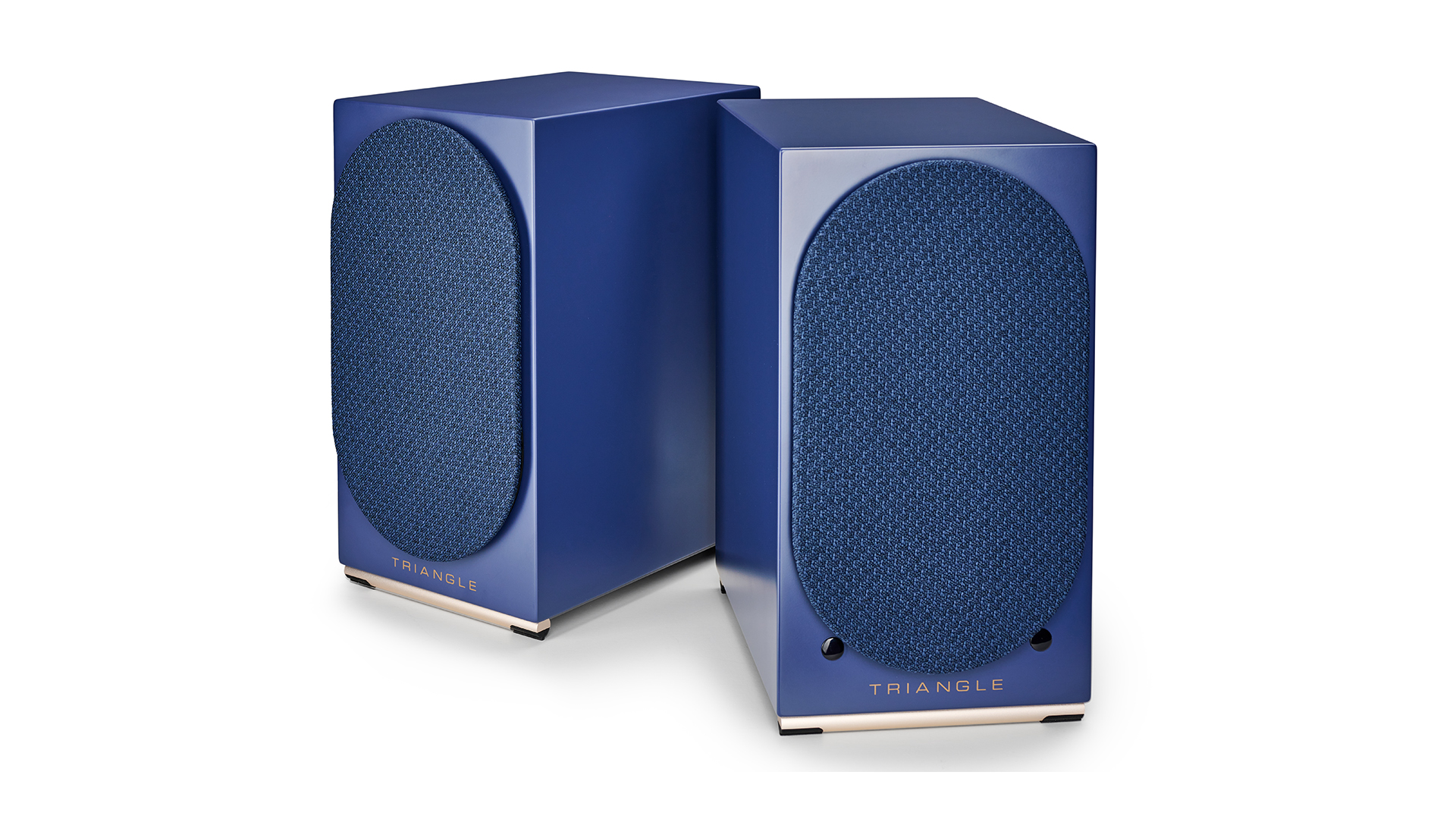
Specifications
Reasons to buy
Reasons to avoid
The Triangle AIO Twin may look like a pair of ‘normal’ speakers, but like the KEF LSX II LT above (and many others on this page), these active speakers are actually a fully-fledged hi-fi system – just more affordable.
This budget price tag isn't reflected by the features on offer, mind you. This Triangle system can play just about anything, from Bluetooth streams from your phone to music files stored on your home network (via wired Ethernet or wi-fi) and even your vinyl records thanks to a built-in phono stage.
It can also be a soundbar alternative for your TV thanks to its optical input. Other physical connections include an RCA analogue pair, 3.5mm aux input, USB-A for charging your phone, and a subwoofer output.
All the major streaming services are supported, too, and you can also play internet radio using the excellent app.
"This system is incredibly fun to listen to", we said in our AIO Twin review. "It’s an enthusiastic performer, happy to tackle any music genre and recording quality, and simply wants you to enjoy the music being played.
But there is also a mature sense of composure running through its veins that is really impressive." We also complimented its knack for timing and dynamics – important musical elements – and its balance across the frequencies. Expect "taut bass, clear voices and sparkling, clean treble that’s punchy but never bright".
Only with the built-in phono stage does it slightly falter. While the peppy character remains the same, it doesn’t sound as clear, precise or expressive compared with the other inputs or network streaming quality, so we would recommend adding an external budget phono stage for an improvement on that front.
If you’re looking for a fun music system that also sounds hugely capable in hi-fi terms, and that you don’t have to pay big money for, this system is worth your attention.
Read our full Triangle AIO Twin review
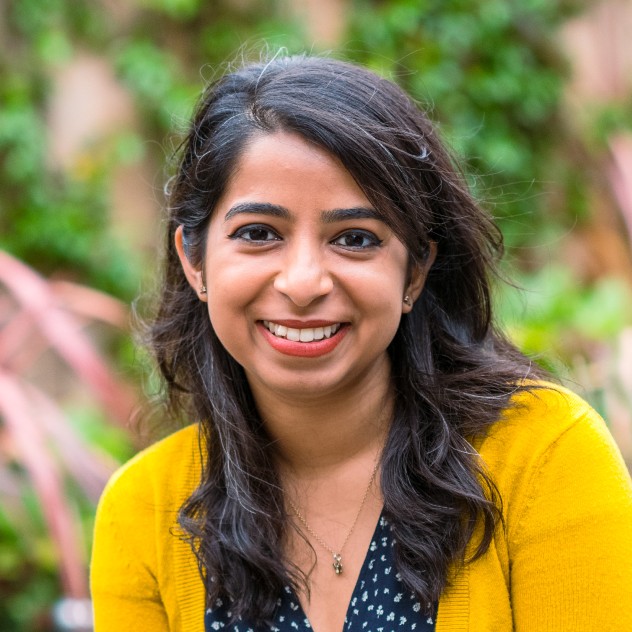
It's pretty remarkable that you can now get a pair of streaming-savvy active speakers at such a modest price point. These Triangles offer so much for so little, making them great upgrades on a one-box wireless speaker like the Naim Mu-so Qb. I wouldn't recommend choosing such a set-up if you predominantly listen to vinyl, though, as the integrated phono stages on such affordable systems tend to lack quality; check out a turntable system instead, and simply add to it a Bluetooth/network receiver if you need to.
The best premium active speakers



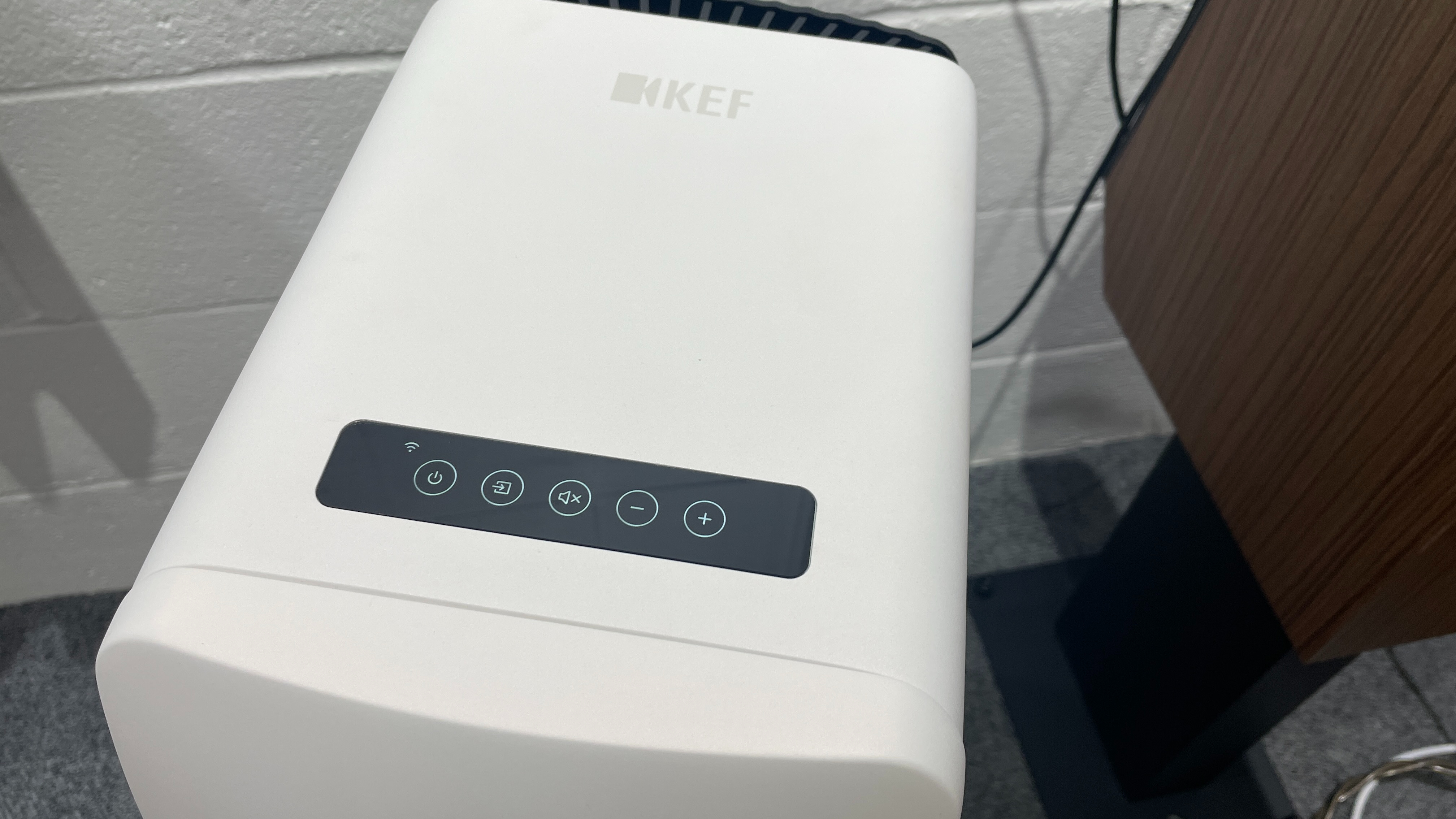
Specifications
Reasons to buy
Reasons to avoid
The original KEF LS50 Wireless active speaker system was pretty unique when it launched and encouraged other manufacturers to follow in their footsteps. Indeed, this long-awaited sequel improves on its predecessor's greatness – no easy feat, even for an audio brand as surefooted as KEF.
Like its illustrious predecessor, the LS50 Wireless II serves as a superb all-in-one (or rather, all-in-two) system by dint of its advanced connectivity and performance. Improvements include upgraded components and a new KEF Connect app from which you can access the likes of Tidal, Qobuz, Amazon Music and Deezer.
These active speakers are also capable of streaming via AirPlay 2, Google Chromecast and Bluetooth, and are also Roon Ready.
KEF's striking design is matched by stunning sonics, enhanced by refreshed Uni-Q drivers and the company's innovative MAT absorption technology, which we awarded an Innovation of the Year award, no less.
The original LS50 Wireless was a breakthrough in sound performance for such an integrated proposition, and the successor only expands on those talents. That “clean and precise” manner and “neatly layered and nicely defined” soundstage are taken to another level here.
The presentation is spacious, with our in-house reviewers noting that "the whole presentation has been opened out, that extra room not only filled with subtler, more precise detail, but also allowing for greater instrument separation that makes its delivery sound much less congested in comparison". The addition of the new MAT technology can be heard in the refined treble and clean mids, too.
Quite simply, if you are in the market for a well-equipped, highly convenient and superb-sounding system packed with streaming smarts, this sophisticated sequel (and big sibling to the LSX II LT above) should top your shopping list.
Read our full KEF LS50 Wireless II review
The best floorstanding active speakers
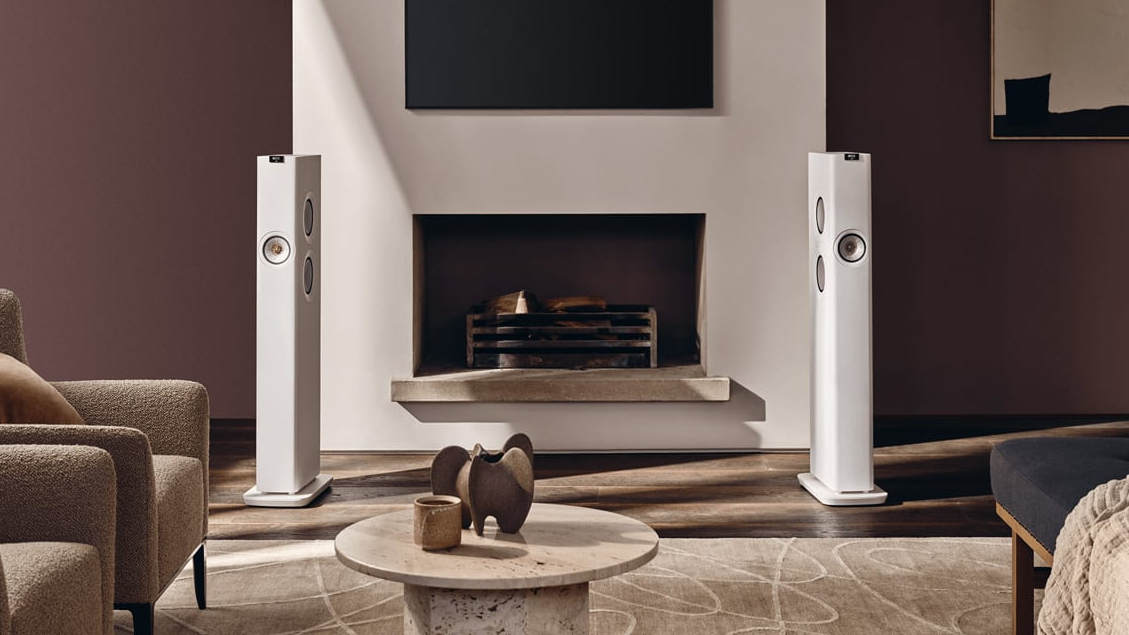

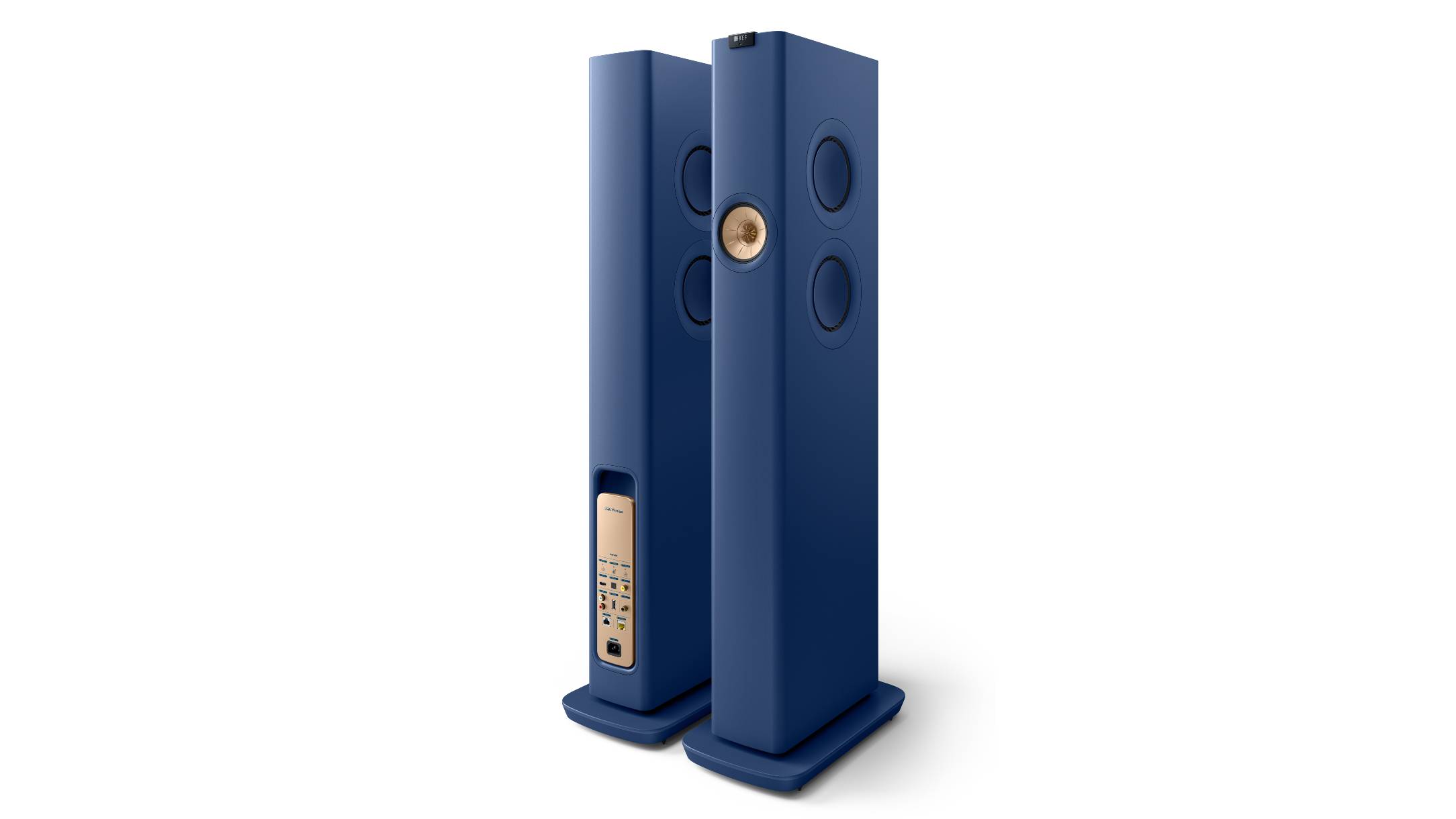

Specifications
Reasons to buy
Reasons to avoid
KEF redefined what you should expect from an all-in-one stereo system with the LS50 Wireless standmounts (above), and it has managed to raise the bar once again with the stunning LS60 Wireless floorstanders, which combine streaming smarts, amplification and stereo speakers into two slim (CD-width!) towers.
But the KEF LS60 Wireless aren't simply floorstanding speakers based on the bookshelf version – such description just doesn’t do it justice. As you can see from the image and asking price above, the company has thrown so much more at the LS60 that it is on a whole different level. If your interest is piqued, we recommend you read our in-depth KEF LS60 Wireless review for everything these beauties can do.
In a nutshell, though, the British brand has managed to combine impressive engineering and a comprehensive feature set with an attractive user experience and top it all off with fantastic audio quality.
Its Swiss-army knife functions include AirPlay 2, Google Chromecast, UPnP, Bluetooth, Roon Ready, Spotify Connect, Tidal Connect and further access to Amazon Music, Qobuz and Deezer. Connectivity spans HDMI eARC, optical, coaxial and RCA stereo, while PCM 24-bit/384kHz PCM, DSD256 and MQA file support cannot be sniffed at either.
And, as our reviewers noted enthusiastically, "it’s fair to say this system serves up arguably the finest audio we’ve heard from such a product so far." The drive units are well integrated and the soundstage has a lovely dimension and spaciousness to it.
Its presentation is fun and lively but also well organised and precise, and we were particularly impressed with how much weight and power on display for speakers so slim.
The LS60 Wireless system is a fine example of modern hi-fi and currently has no real rival if you are in the market for a convenient yet premium floorstanding solution.
Read the full KEF LS60 Wireless review
The best high-end active speakers
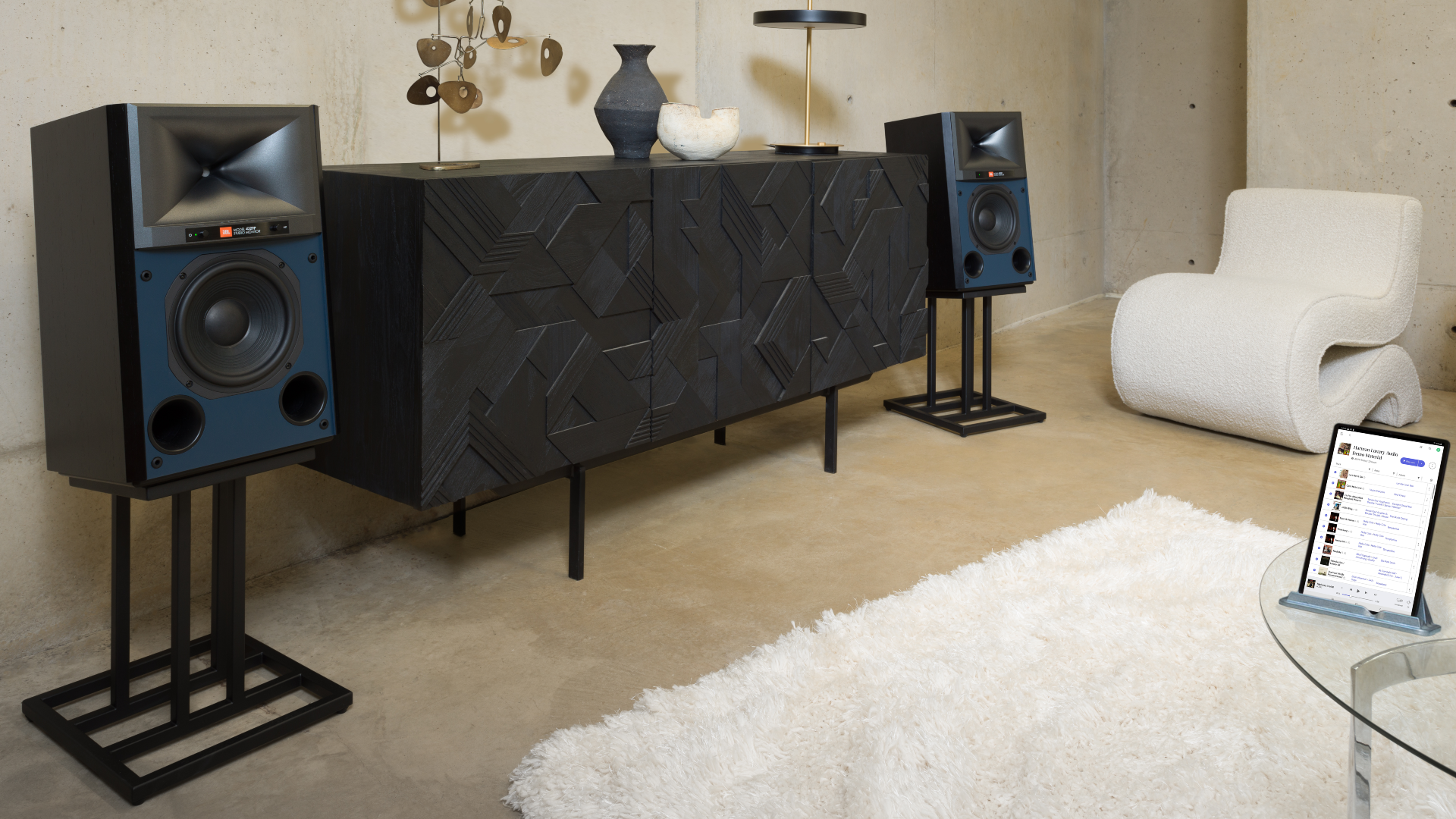
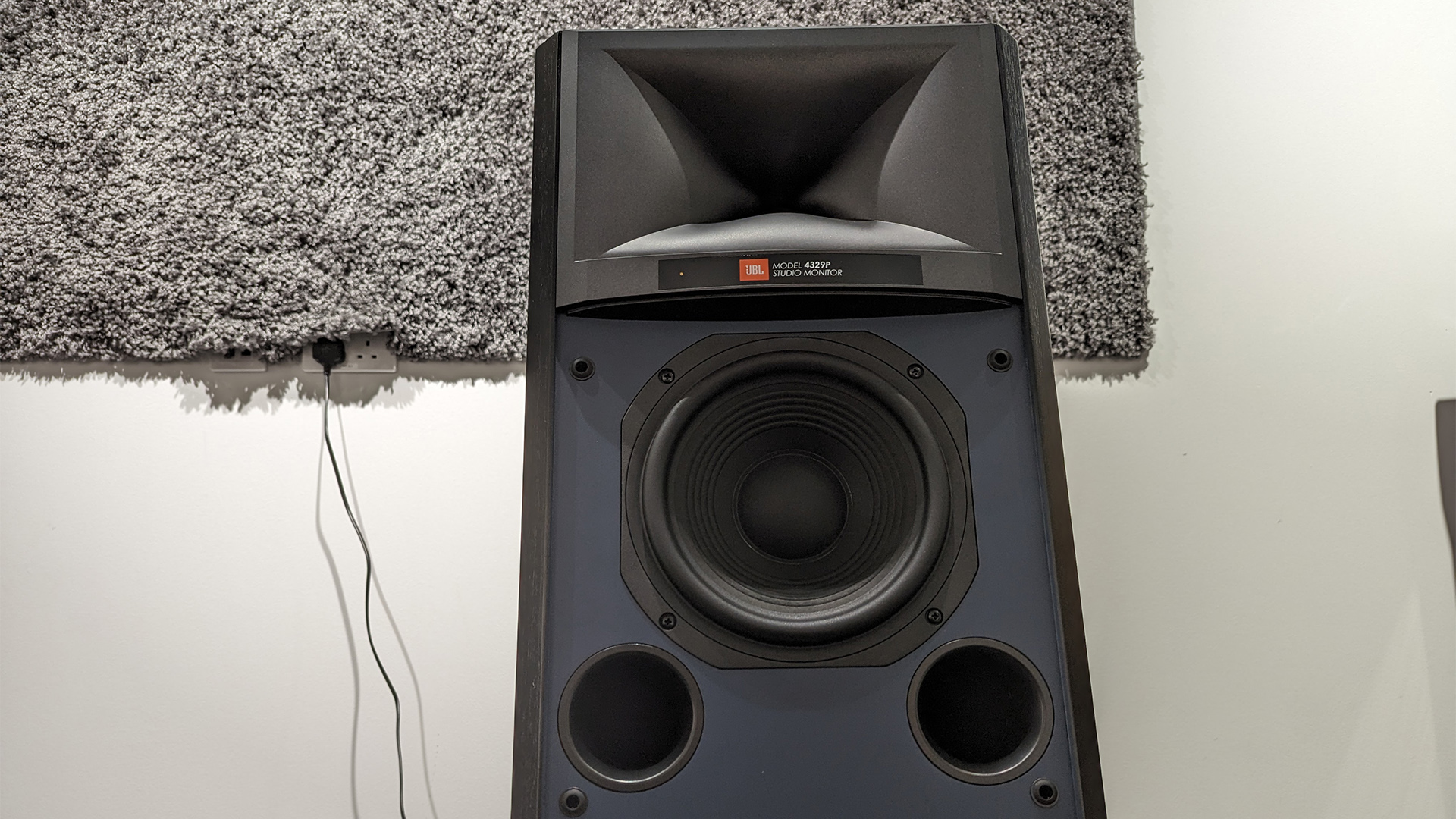
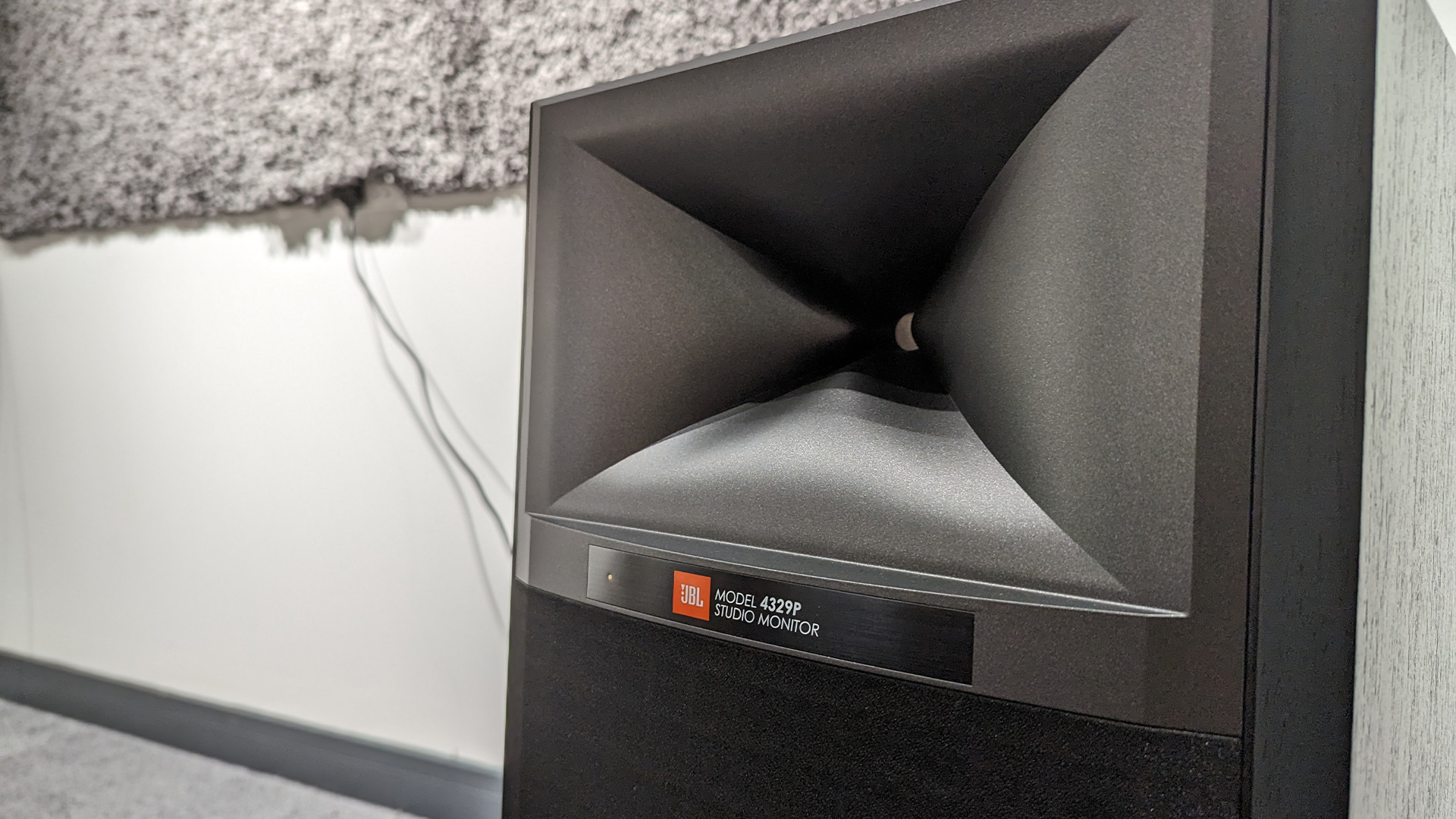
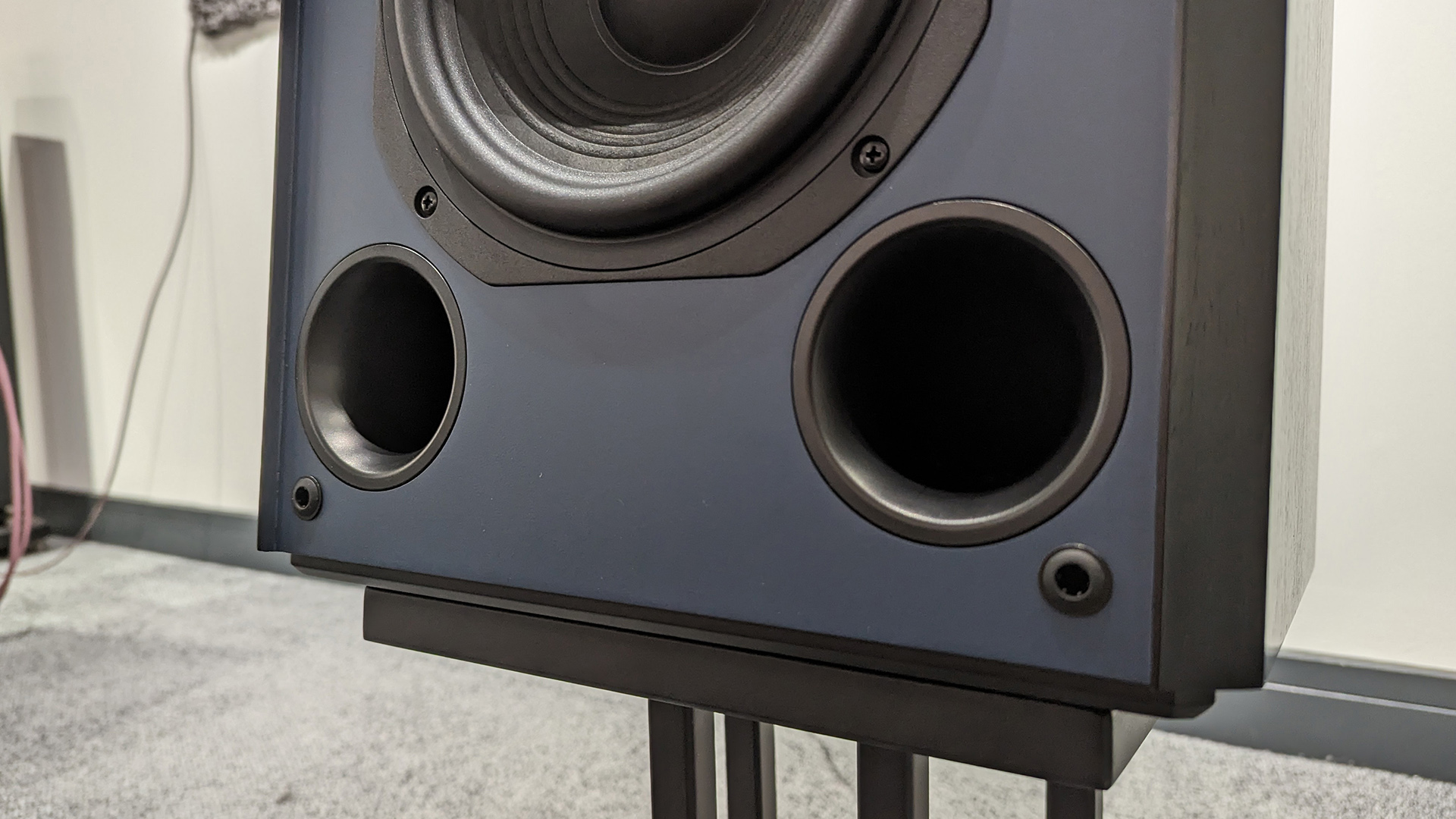
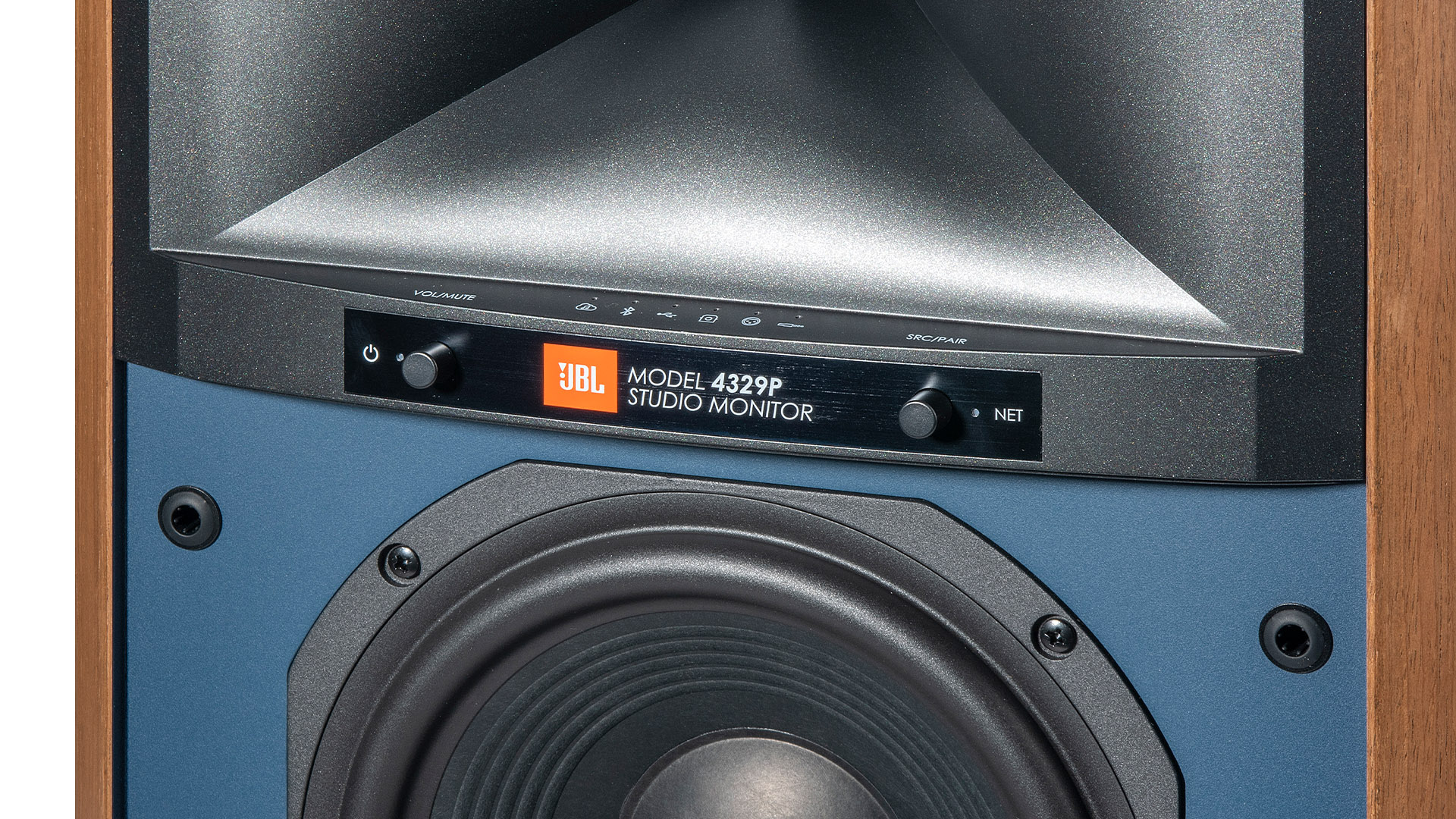

Specifications
Reasons to buy
Reasons to avoid
Active speakers are often designed to save you space, but you’ll need plenty of it if you decide to buy a pair of JBL’s 4329P Studio Monitors.
These are big, imposing speakers – and not only because they have all of the amplification and streaming circuitry built in.
Each speaker is powered by a 300-watt amplifier, with 250 watts going to the 20cm woofer, and the rest feeding the 25mm horn-loaded driver – so it’s no real surprise they weigh over 15.5kg each. For comparison's sake, they're perhaps double the size of the KEF LS50 Wireless II above.
The sound they produce is equally large and powerful – able to really convey the scale and size of a recording. Its bass extension is really able to anchor bass chords, too. It's here that they trump the KEFs most significantly, even if we find the KEFs slightly more musical overall.
Despite the JBL's fun drive and unquestionable clout, there’s no lack of subtlety or tonal balance here. Indeed, it is no brute: "There’s a sophistication brought by decent levels of dynamic expression here, as well as a smoothness to the midrange that ensures vocals sound pleasingly lush and full," we said in our 4329P Studio Monitor review. Dynamic expression is also highly impressive.
The treble could be a bit more refined, and Bluetooth performance is noticeably weaker than the presentation through the wi-fi or wired connections, but there’s no denying the JBL’s presence and talents.
Each speaker needs mains power, and if you connect them together using an ethernet cable you unlock 32-bit/192kHz playback (the wireless link is limited to 24-bit).
However you choose to set them up, there are plenty of options when it comes to music playback; AirPlay 2, Google Chromecast and DLNA are all supported, plus there are balanced XLR, Toslink/optical, USB and 3.5mm inputs.
There’s also a subwoofer connection if you'd like to add more bass power, but low-end heft is not something these speakers lack!
Looking for something with a slightly more subtle aesthetic? The similarly priced Dali Rubicon 2 C might be more up your street.
Or if you want this system concept but in a much higher-performing (and pricier) package, check out the fabulous, newly reviewed Focal Diva Utopia.
Read our full JBL 4329P Studio Monitor review
The best active speakers for purists
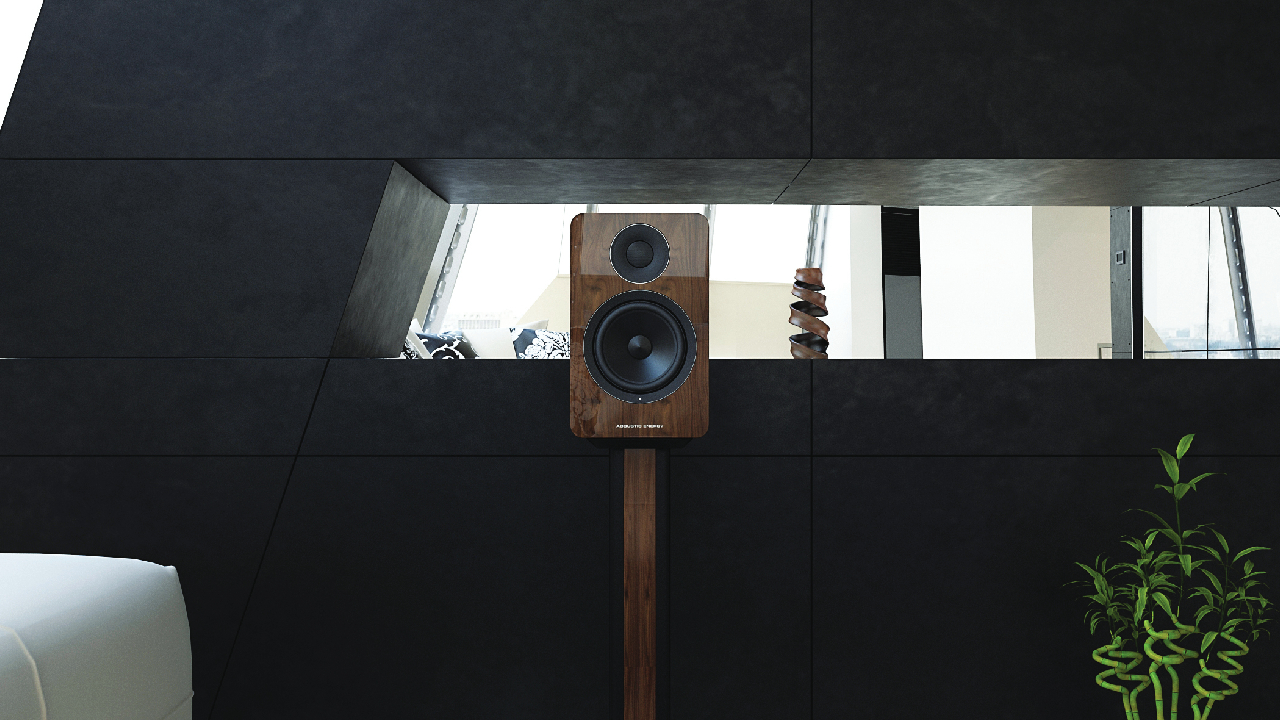

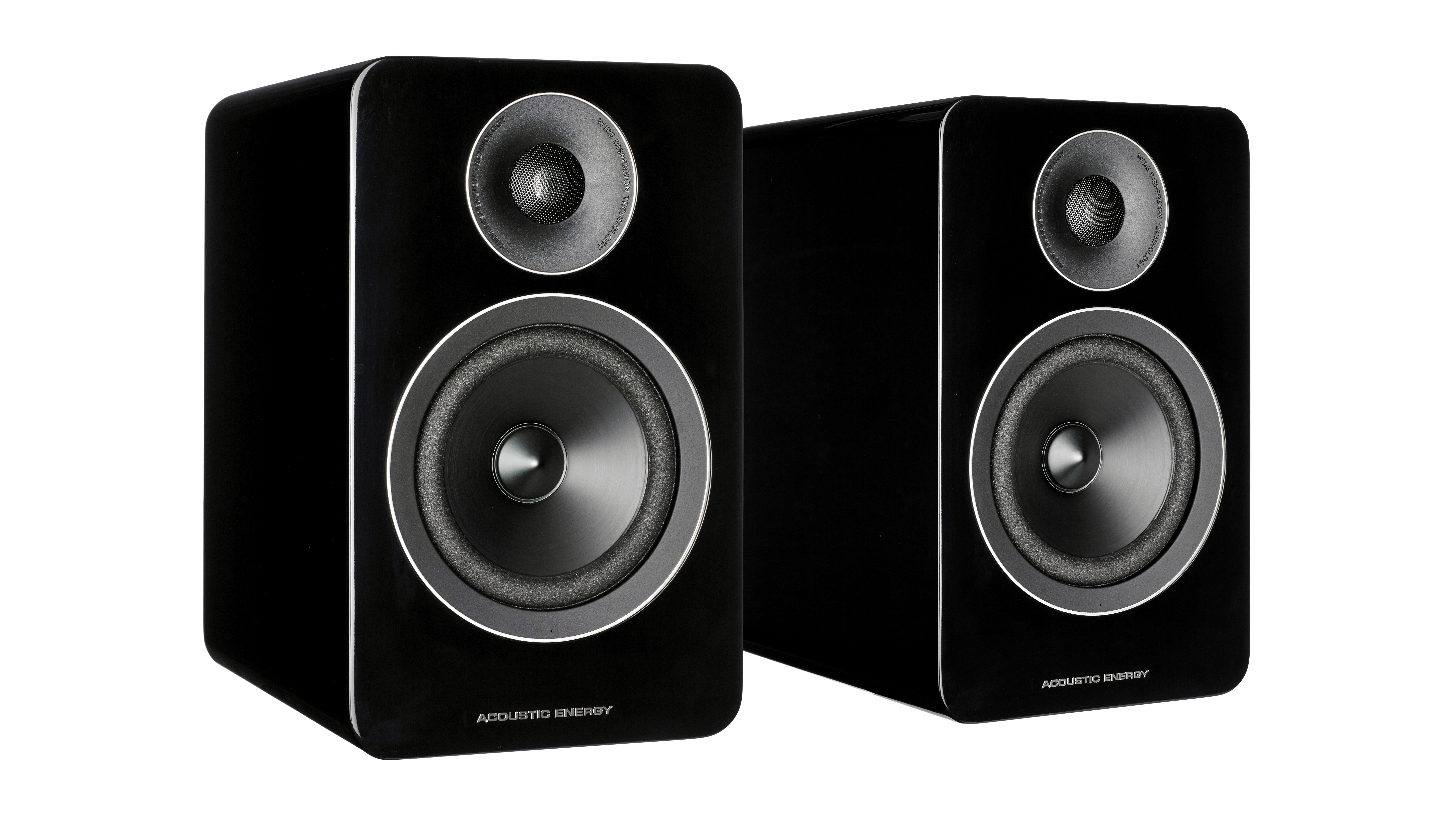

Specifications
Reasons to buy
Reasons to avoid
Look at these Acoustic Energy active speakers in relation to other entries in this list and they might be considered a little basic in terms of what they do and how you set them up. But you won't hear any complaints from us; simplicity is no bad thing, especially when the performance results are as good as this.
There is no Bluetooth or wi-fi connectivity – just RCA or balanced XLR inputs for connecting your source components. But the AE1 Active do feature adjustable controls for bass and treble, so you can fine-tune their sound to suit your particular room. Power comes from a dedicated 50-watt class A/B power amplifier module for each drive unit.
Sonically, these speakers are very impressive. There is plenty of body in the mid-range, delicate control in the treble and bags of rhythm to get your head nodding. They also have a keen sense of punch and drive, the timing is spot on, and the dynamic range subtle yet extensive.
Our in-house reviewers thoroughly enjoyed their time with the Acoustic Energys: "The range of music we play while testing – and the time spent listening, unable to tear ourselves away – is testament to their talent," our AE1 Active review states. "We get through a hefty chunk of our library over a number of days, and with each album the AE1s’ response is absolutely a delight."
At this price, you would be hard-pressed to find a group of separates to match this performance. If you're looking to cut just one box (the amplifier) from your system and connect your existing sources, the AE1 Active are solid propositions.
Read the full Acoustic Energy AE1 Active review

If you want to combine stereo speakers and amplification but still prioritise sound quality, I'd recommend buying active speakers that don't integrate loads of features like network streaming – especially if you don't need them. Such implementations cost and, ultimately, chip away at the engineering budget. Something more purist, like these Acoustic Energys, offers performance and convenience while allowing you to add only the sources you need.
The best desktop active speakers
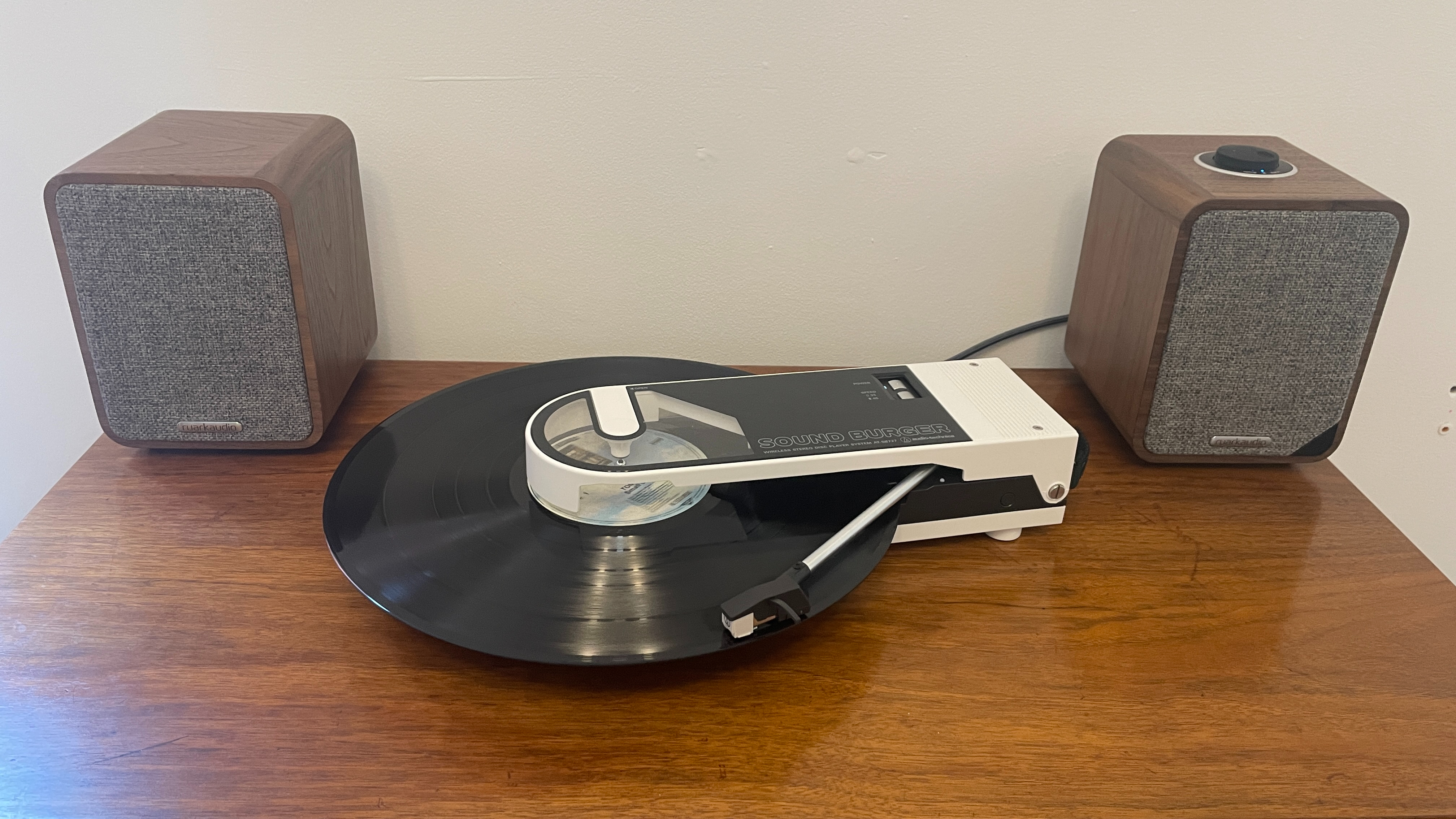

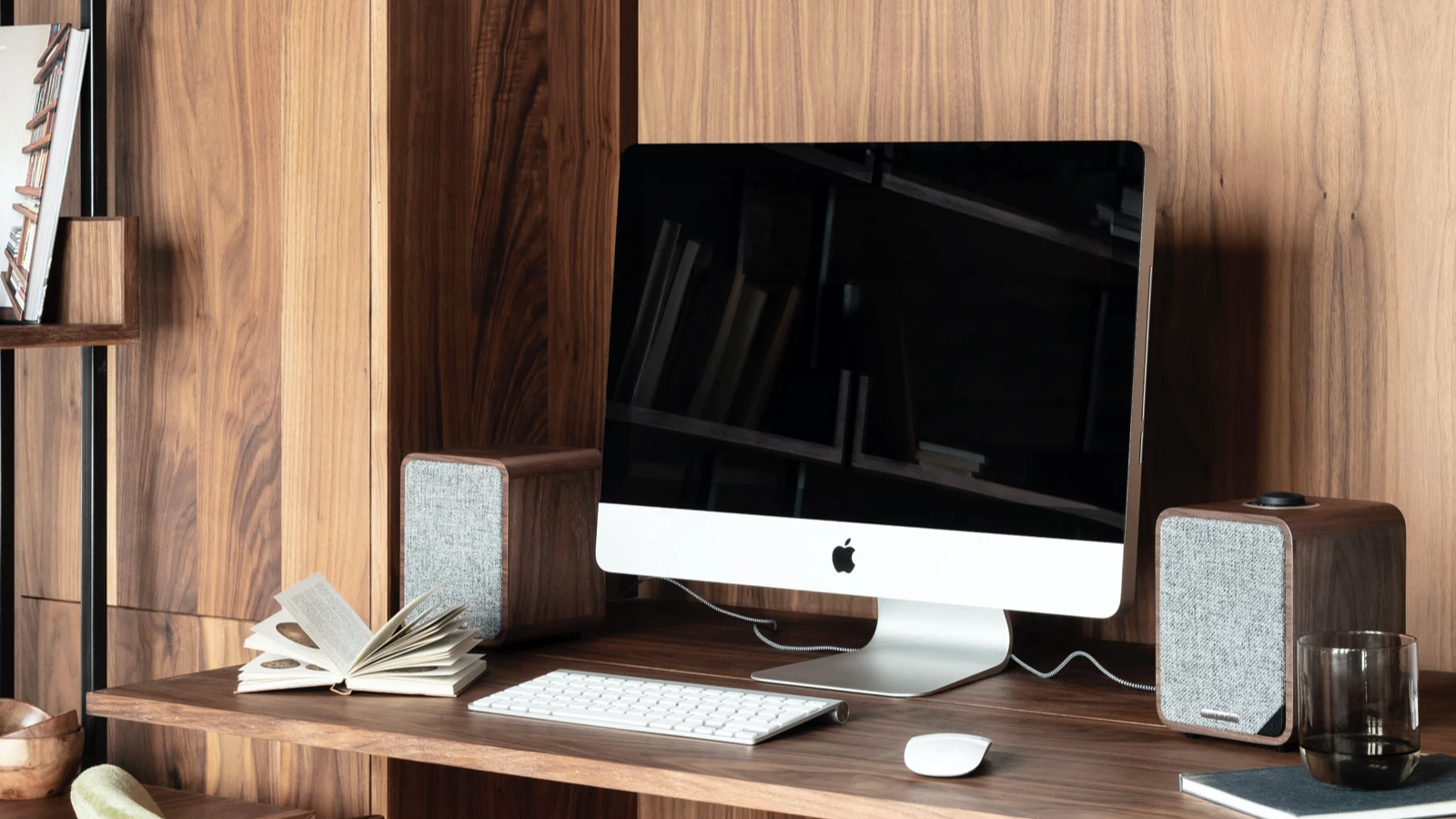
Specifications
Reasons to buy
Reasons to avoid
With their retro wood-and-grey styling, these super-smart Ruark Audio speakers will look at home on almost any surface, be it an office desk or a kitchen work surface.
But they are not just lookers; they are the desktop speakers that come closest to sounding like a proper hi-fi set-up and, over their two generations, have consequently won more What H-Fi? Awards than we care to count. So while they might be small, make no mistake, they are most definitely mighty.
While you naturally shouldn't expect the size and scale of sound offered by the physically larger entries on this list, the MR1's soundstage is gloriously spacious, giving each instrument enough room to breathe. And nothing in a mix trips over itself.
We called them "wonderfully musical" in our MR1 Mk2 review, praising their rich detail, fluid dynamics and a good level of subtlety. Their pure, textured vocal delivery is a highlight, as is their taut, punchy bass – arguably surprising considering their price and size.
You have to look to Ruark's one-box radio music systems, such as the R5, for network connectivity, as these stereo speakers settle for Bluetooth and physical connections – specifically an optical input that can support hi-res audio up to 24-bit/192kHz, plus a 3.5mm aux input and subwoofer output.
Other handy features include the ability to use the main right speaker as a single mono speaker, and an optional battery pack to make the MR1 portable if you so wish.
All in all, these are superb active speakers of their type.
As an alternative, the Elac Debut ConneX DCB41 are nowhere near as compact but do come with an HDMI ARC connection rather than the MR1's optical one, making them even better suited for connecting to a TV.
Read our full Ruark MR1 Mk2 review
Also consider
Elac Debut ConneX DCB41: Another powered set-up (where one speaker contains all the electronics while the other is a conventional passive design), this is as entry-level as such active stereo speakers come. So it's surprising how well-featured (HDMI ARC, USB, line/phono, optical, Bluetooth) and decent-sounding they are.
ATC SCM20ASL: For the right person, these ATCs are stunningly rewarding. We make that 'right person' caveat advisedly, as while they're exceptionally insightful and transparent, their honesty-first approach won’t suit all. Plus, you'll need a decent wad of cash (£6495 / $9999 / AU$12,950) if you want to get your mitts on a pair.
Klipsch The Fives: A one-stop shop for home audio, these decent active speakers will suit those who want a pair for movies as well as music. No network streaming, but they will connect to virtually anything – an HDMI ARC socket for TVs is joined by analogue RCA/phono, 3.5mm aux, digital optical, USB and Bluetooth.
Dali Rubicon 2 C: A very fine pair of active speakers that prioritise performance over feature box-ticking. With optical, coaxial, RCA and 3.5mm connections housed in a separate hub box, the speakers are simple to operate and enjoyable to listen to.
Focal Utopia Diva: Everything you need in two cabinets, including a truly high-end performance that, when it comes to clarity, precision and bass performance, has little to fear from separates alternatives at the same price. Utterly high-end, yet utterly impressive.
Recent updates
- August 2025: Added the ATC SCM20ASL to our also consider section following a five-star review.
- March 2025: No new reviewed entries make this revered list, although there is a brand-new entrant in the market: the Dynaudio Confidence 20A, which are supposedly "the biggest upgrade in active hi-fi in over a decade". Big claim!
- January 2025: If your integrated speaker system ambitions go way beyond our high-end active speaker pick, take a look at the newly reviewed and sensational Focal Utopia Diva, which we have just added to this guide's Also Consider list.
- November 2024: Fresh from its What Hi-Fi? Award 2024 win, the KEF LSX II LT replaces the pricier and older LSX II as our Best Overall pick. Other Award winners in this list have also been labelled as such. We look forward to seeing whether the newly announced Technics CX700 can trouble the KEF LS50 Wireless II in this list, too, and whether the brand-new Focal Utopia Diva (in for testing) can justify its lofty price.
- August 2024: No new entries this time, as the newly reviewed Triangle Capella couldn't quite dethrone the class-leading KEF LS50 Wireless II on this list.
- March 2024: Added an 'Also Consider' section (above) to give readers more recommendable options to consider.
- January 2024: Added a 'how to choose' section (below) to help readers learn what aspects should determine their buying decision.
- November 2023: Newly crowned What Hi-Fi? Award winners added and labelled. List curation becomes more focused.
How to choose the best active speakers for you
Active speakers have traditionally required sources to be connected to them, as is the case with the Acoustic Energy AE1 Active in this list. But nowadays many integrate Bluetooth and, increasingly, even network streaming, essentially making them complete hi-fi systems – such as the few KEF LS systems above.
As with everything, though, streaming implementation costs more and can affect the engineering of a product, so choose active speakers with streaming included only if you intend to use the feature. You can always connect a dedicated music streamer down the road for high-performance streaming, or even just a Bluetooth receiver if you're happy casually streaming music over your phone from time to time.
Generally speaking, while sound and aesthetic preferences are important factors in your buying decision, so are connectivity options – which active speakers you choose should also be based on how much source integration you require. For example, if you want to connect a TV as one of your sources, look for a pair with an optical input or, better yet, an HDMI socket.
If you want to play vinyl through your active speakers, you'll need either your record player or speakers to have a phono stage. If your turntable doesn't have one, look for active speakers with one integrated – and check our reviews for its performance ability – otherwise you will have to add an external phono stage between the two components.
Finally, if you choose standmount (or 'bookshelf') active speakers, save room in your budget for a pair of high-quality speaker stands for them to perch on, unless their design suits a desktop. Placing them on solid, sturdy stands will allow them to work optimally.
FAQ
What are active speakers and how do they work?
Stereo speakers can be categorised into two different species – active and passive. Passive speakers are your 'standard' driver-filled boxes that require an external stereo amplifier to make a sound. Once the signal from the amplifier reaches these boxes, an internal crossover filters the appropriate frequencies to each driver.
Some speakers are passive in nature but still have an amplifier built in – often squirrelled away into just one of the two boxes. These are commonly referred to as 'powered' and represent most of the more affordable amplified speakers, such as the Ruark Audio MR1 Mk2 on this list.
Now, active speakers. These have amplifiers built in as well, but this time they have one amp dedicated for each 'way'. So, a two-way speaker with one tweeter and one mid/bass driver unit will have two power amplifier modules.
These models are fed by an 'active' digital crossover that works at a much lower voltage than their passive cousins. That means the components can be optimised for precision rather than pure power handling, resulting in a potentially better integrated, more precise sound.
How do you connect active speakers to a TV?
There are two common methods of connecting your TV to a pair of active speakers – via optical or HDMI ARC/eARC. (RCA and 3.5mm sockets used to be popular methods, but even the best TVs rarely sport these nowadays.)
Optical and HDMI ARC can both carry stereo PCM (uncompressed) and Dolby/DTS 5.1 (compressed), though HDMI eARC has greater bandwidth and can therefore transmit the next-gen Dolby Atmos and DTS:X surround sound formats. This distinction shouldn't make much difference to how you listen to TV via your stereo active speakers, mind you.
Note that ARC/eARC allows your main TV remote to control the basic volume and power functions of your soundbar via HDMI CEC (Consumer Electronics Control) – optical does not.
For more detail, check out how to connect your speakers to your TV.
Can you use active speakers with a turntable?
Yes, but either (or both) your active speakers or turntable must have a phono stage. This is necessary to raise your turntable's audio output to line-level and deliver a sound you can hear through your system. At the same time, it also adds standardised equalisation.
If your turntable has a built-in phono stage, it can connect directly to an active speakers' RCA inputs. If it doesn't, it can connect to your active speakers' dedicated phono-toting RCA input (typically this comes with a switch to turn the RCA input to 'phono' mode).
If neither do, you'll need to connect a separate phono stage box between the speakers and turntable.
How we test active speakers
We have state-of-the-art testing facilities in London and Reading, where our team of experienced, in-house reviewers test every bit of hi-fi and AV kit that passes through our door – including active speakers.
What Hi-Fi? is all about comparative testing, so we listen to every pair of active speakers we review against the current leader in its field to gauge how it compares to the best-in-class competition.
We keep What Hi-Fi? Award winners, such as the Ruark Audio MR1 MkII and KEF LS50 Wireless II in this category, in our stockroom so we can always pit new products against ones we know and love. And we do our best to review as many new models in as many markets as possible to ensure our contextual knowledge is the best it can be.
We are always impartial in our testing and ensure we hear every pair of active speakers at its optimum, with sources we know and like. We test them in their best use case with different partnering source kit, whether that is a phone or laptop playing from a supported streaming service over wi-fi or Bluetooth, or a price-comparable wired source component.
Each input a pair of active speakers offers is tested so that we can gauge performance consistency. And we play plenty of different types of files and music genres through them to ensure they meet their file support specification and have sonic talents that suit a wide range of musical tastes.
Naturally, we give each pair several days of listening time (and at least 48 hours to run in), too.
All review verdicts are agreed upon by the team as a whole rather than an individual reviewer, to eliminate any personal preference and to make sure we are being as thorough as possible.
There is no input from PR companies or our sales team when it comes to the verdict, with What Hi-Fi? proud of having delivered honest, unbiased reviews for decades.
Today's best deals
The latest hi-fi, home cinema and tech news, reviews, buying advice and deals, direct to your inbox.

Kashfia is the Hi-Fi and Audio Editor of What Hi-Fi? and first joined the brand 13 years ago. During her time in the consumer tech industry, she has reviewed hundreds of products (including speakers, amplifiers, turntables and headphones), been to countless trade shows across the world and fallen in love with hi-fi kit much bigger than her. In her spare time, Kash can be found tending to an ever-growing houseplant collection and shooing her cat Jolene away from spinning records.
- Harry McKerrellSenior staff writer
- Tom Wiggins
